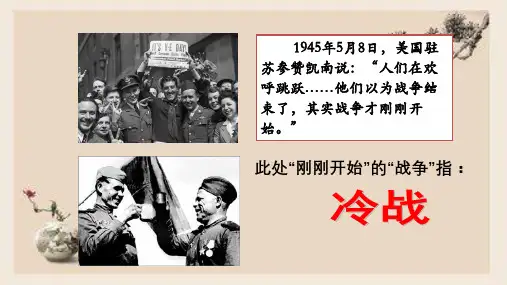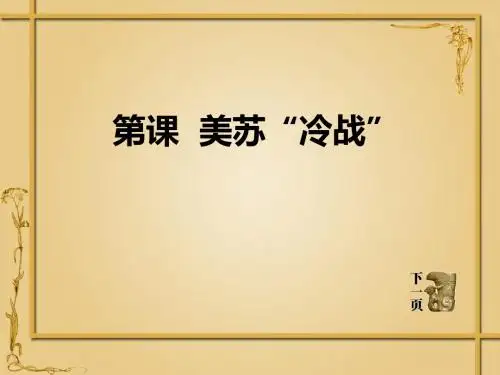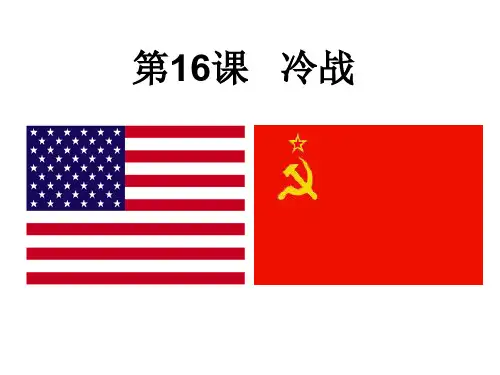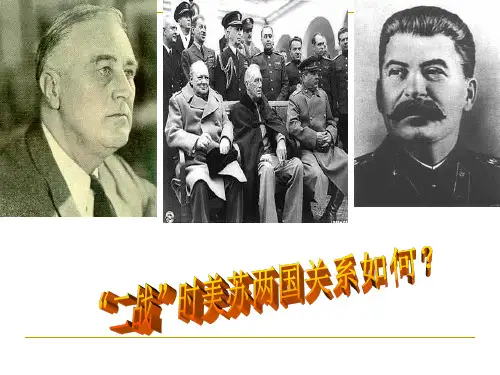cold war。美苏冷战 英语版。最全最完整的版本。啵啵独家制作精编版
- 格式:ppt
- 大小:5.06 MB
- 文档页数:12
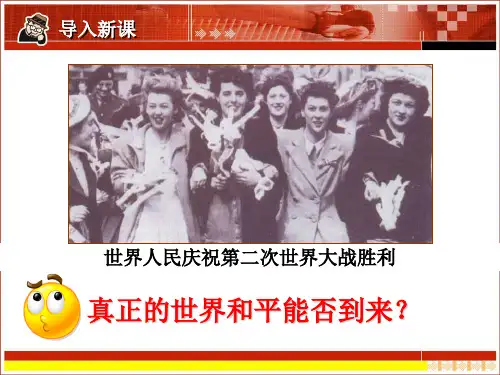
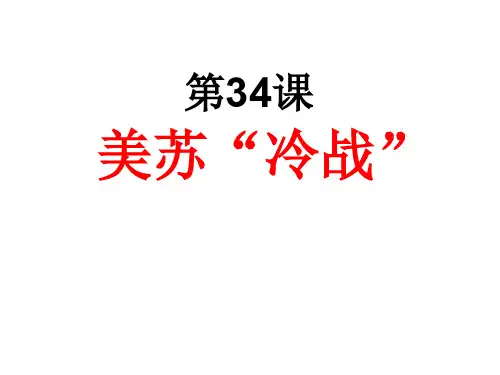

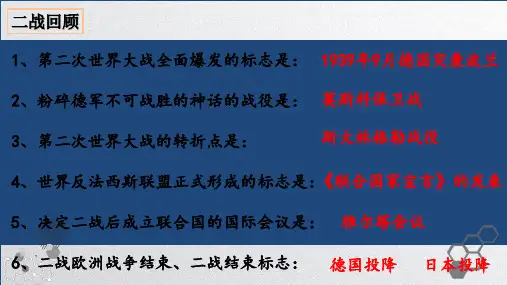
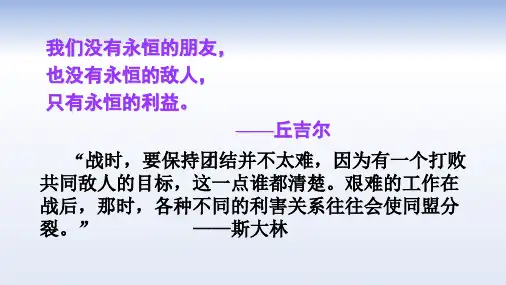

关于冷战的起因经过结果和影响;英语版论文;Cold War(US)130247082 Yuki130041021 Sunny130041022 Apple130288027 Charlene130075034 HaileyIt’s beli eved that the origin of the cold war was directly related to the relationship between the Soviet Union and the Allies (United States, United Kingdom and France) in the years of 1945-1947. In the end, the Soviet Union and the United States Army in Adolf Hitler's Nazi empire in Europe and the United States got a complete victory.In 1945, the United States and the Soviet Union were allies, and they were both the winners in the Second World War. However, wartime allies finally became mortal enemies, locked in a global struggle of politics, economy, military affairs, and there was thought to be another new "Cold War" just a few years later.During and after the Second World War, a series of events exacerbated the tensions, including subsequently results in the first two years of the war of the Soviet-German pact. The amphibious invasion of German occupied Europe perceived latency and supported of the Atlantic Charter of the Western allies. The western allies' support for the Atlantic Charter, disagreement in wartime conferences over the fate of Eastern Europe, the Soviets' creation of an Eastern Bloc of Soviet satellite states, western allies scrapping the Morgenthau Plan to support the rebuilding of German industry, and the Marshall Plan.Finally, the Yalta agreements were not so really compromise as misunderstanding (in the short term) among the three leaders. When Stalin left, he was very happy, and he won the British and American control of Eastern Europe, Churchill and Roosevelt. However, the two parts of the agreements are mutually exclusive, what if the Eastern European people trying to decide their own orbit from the Soviet Union's own words will happen? In the future, the Yalta agreements are not only possible; they are almost inevitable. Reference:[1] 陈开仁.冷战——实力与谋略的较量.Beijing,中共党史出版社,1997Actions America took in Cold War consists of four parts:2.1.Part 1: The establishment of containment strategy (1947-1953)First, the introduction and implementation of the Marshall Plan represented the intention of to send large-scale economic aid to Western Europe as a way to avoid the expansion of communism in Europe. Second, the intervention of the Italian election in 1948. America offered economic aid, political campaign, intelligence activities and covert operations to help Democratic Party win the election, which fostered the Cold War pattern in Europe. Third, American cold war policy in Asia. It drove a wedge between the Soviet Union and China to prevent the Soviet Union from controlling Asia. It signed San Francisco Treaty of Peace with Japan to expand its influence in Far East.2.2.Part 2: The globalized Cold War and the national strategy of Cold War (1953-1962) First, American cover operation was used to handle the communism in Guatemala, Which is called Operations PBSUCCESS, to weaken the power of the Soviet Union and communism. Second, American policy to Eastern Europe was to strengthen contact with Eastern European countries to disintegrate relations between them and the Soviet Union. Third, the doctrine of ‘massive retaliation’ became an important component in Eisenhower’s “national Cold War Strategy” to develop its military position against th e Soviet Union.2.3.Part 3: American action in response to out-of-balance. (1962-1969)First, America and the Soviet Union handled Cuban Missile Crisis, altering the Third World War and gaining a good reputation, which relieved their relations to some extent.Second, as China became a country owning nuclear power, America gradually admitted the legality of the People’s Republic of China. It laid foundation for the improvement of their relations.2.4. Part 4: The Transformation of the Cold War and the Overall Adjustment of American Strategy (1970-1973)First, the Nixon doctrine was applied and American foreign policy was adjusted to deal with the conflicts and differences with Europe, China, Japan and the Soviet Union. (The policy is that America established a new international order with Europe, China, Japan and the Soviet Union) Second, America made use of the Nixon administration’s triangular strategy to improve the relation with China and stand in an advantageous position in the demulcent relationship with the Soviet Union. Meanwhile, relationship between China and the Soviet Union would not be close.Reference:[2] Ncs162/2, Basic National Security. Digital National Security Archive, 1953,[3] 沈志华.冷战时期美国重大外交政策案例研究.经济科学出版社,20143.The end of the Cold WarThe Cold War collapsed, as widely known, thanks to the dismantling of the USSR. Here are some reasons for the desire for an end, and factors that accelerated the disintegration of USSR. Both America’s president Ronald Reagan and USSR’s premier Mikhail Gorbachev played big roles in it.3.1. Economic reasonsEconomically, the Soviet Union failed to meet the domestic needs because of theirrational involvement in Mr. Carter’s arms race of B1 bomber and MX missile and Mr. Reagan’s star wars, the escalating spending on the frustrating Afghanistan war and the economic stagnation inside the union. Gorbachev’s reforms, with piles of western goods, ideas, and services flooding in, and the flagging, inefficient absolute centralized economy itself, provoked the demand for an immediate move to capitalism.3.2. Political reasonsPolitically, Gorbachev, the revolutionary leader, promoted the liberalization of the political landscape, which unluckily, to the furthered frustration of the frustrated USSR leadership, waked the crazy little sleeping beauty of freedom deep in the civilians under manacles up. Then followed the movements in Eastern Europe, and the irresistible claiming for independence of the USSR’s used-to-be loyal brothers, while USSR inclined not to interfere. The union broke up.“For foreign policy, Gorbachev tossed the ‘international class struggle’ idea, and discarded the use or threat of force in dealing with conflicts.” (Who ended the Cold War?)3.3. Military reasonsAs for military forces, the Soviet announced a reduction by 500,000 troops and a withdrawal of 50,000 soldiers from east Europe. Additionally, the decades-long enmity between the superpowers asked a peaceful end, for common interests. Negotiations —not military confrontations— constituted the core of Reagan’s strategy in dealing with the Soviet, while Gorbachev initiated a series of summit meeting with Reagan and Bush senior, including the massive reduction in nuclear weapons.Reference:[4] Paul C. Demakis. (2009, 11). Who ended the Cold War? Retrieved from: /bostonglobe/editorial_opinion/oped/articles/2009/11/05/who_end ed_the_cold_war/10[5] Michael Cox. (n.d.) Ronald Reagan and the End of the Cold War: The Debate Continues.[6]Informationon:https:///history-by-era/age-reagan/essays/ronald-reagan-and-end-cold-war-debate-continues4.The effects of the Cold warThe legacies of the Cold War continues to influence world in various affairs4.1.Technological legaciesNuclear legacies from the Cold War benefits a lot in the carefully managedapplication of radiation and other nuclear processes, such as the application ofnew technologies in nuclear weapon, radiation in medical treatment.Improvement in environmental remediation, industrial production, scienceand technology were also remarkable.But there were dark clouds. Potential insecurity threatened nations andinternational relationships. Nuclear weapons played an important role inprotecting and stabilizing those powers who own that. However, it broughtmany disadvantages at the same time. The bombings to Hiroshima andNagasaki caused large-scale destruction through intense blast and fire, as wellas severe and lasting radiation. Moreover, people e involved in the research of nuclear weapons, such as the scientists, technicians and military personnel, were exposed to the radiation, which generated serious impact on them. Several significant accidents happened at nuclear reactors or facilities, the leaked radiation causing direct fatalities to the professionals involved and the public. Moreover, although the Cold War has ended, domestic basing and overseas deployment of nuclear weapons are still there. Moreover, the nuclear-weapon states remain in various reduced but palpable conditions of defensive alert. Worse is that deliberate, accidental, or unauthorized nuclear devastation remains, and terrorists and hackers continue to interfere with nuclear stability and confidence in it.4.2.Economic legaciesThe Soviet Union collapsed partly due to economic weaknesses. After it’s falling apart, world is widely considered as unipolar, the United States remaining the sole superpower Cold War was a huge problem placed on many economies. Financial obligations avoid further dislocations in the transition from a wartime footing to a peacetime environment. National military establishments and alliances had to be reset. Highly dependent institutional frameworks were to be restructured, and new obligations were acquired by nations that were once bystanders to the East-West confrontation.In the wake of the Cold War, freed or newly-founded nations inherited expenses, commitments, and resources for which they were not prepared.Some also found themselves under modern national-security burdens and with substantial environmental contamination legacies. Everything needs to be financed when new or revised civilian economy had to be instituted. Since the superpowers carried much of the confrontational burden, both Russia and the United States ended up with substantial economic liabilities.4.3.Cultural LegaciesIn Cold War, popular culture including music, films, and fashion were affected by the political and social clashes.Music styles sometimes showed connections with the Cold War in its emotions and lyrics. Punk music expressed their hatred of leaders; music from the hippie movement was against the Vietnam War. It was when rock and roll emerged.Films about the dangers of communism were produced. There was a variety of different themes in this category. Many movies shows the denouncing of a friend or family member as a communist associate. Another theme portrayed a third World War fought with nuclear weapons.In literature, the prevalent themes were about the terrible side of the world.In dressing styles, many youths wore tie-dye clothing, moccasins and headbands. For men, sleeveless sport shirts were popular and worn with white pleated trousers and a belt. Woman would wear A-line and pencil skirts. In addition, in the 1960’s, dresses usually had a mod style with bold and colorful patterns, commonly reached the knee, stylish with ruffles or laces.Reference[7] "The Effects of the Cold War on us Education by Michael Totten".Education Space 360. Retrieved 2013-11-27.[8] United States of America. BBC News. Retrieved on March 11, 2007[9]https:///u-s-history/textbooks/boundless-u-s-history-textbook/the-challenges-of-globalization-and-the-coming-century-after-1989-31/the-george-h-w-bush-administration-229/the-effects-of-the-cold-war-1306-3113/[10] Whitfield, Stephen J, “The Culture of the Cold War”, Johns Hopkins UnivPr, 1996-4[11] Olivia, “Cold War and Popular Culture in the Western World”Bibliography:[1] 陈开仁.冷战——实力与谋略的较量.Beijing,中共党史出版社,1997[2] Ncs162/2, Basic National Security. Digital National Security Archive, 1953,[3] 沈志华.冷战时期美国重大外交政策案例研究.经济科学出版社,2014[4] Paul C. Demakis. (2009, 11). Who ended the Cold War? Retrieved from: /bostonglobe/editorial_opinion/oped/articles/2009/11/05/who_end ed_the_cold_war/[5] Michael Cox. (n.d.) Ronald Reagan and the End of the Cold War: The Debate Continues.[6]Informationon:https:///history-by-era/age-reagan/essays/ronald-reagan-and-end-cold-war-debate-continues[7] "The Effects of the Cold War on us Education by Michael Totten". Education Space 360. Retrieved 2013-11-27.[8] United States of America. BBC News. Retrieved on March 11, 2007[9]https:///u-s-history/textbooks/boundless-u-s-history-text book/the-challenges-of-globalization-and-the-coming-century-after-1989-31/th e-george-h-w-bush-administration-229/the-effects-of-the-cold-war-1306-3113/ [10] Whitfield, Stephen J, “The Culture of the Cold War”, Johns Hopkins Univ Pr, 1996-4[11] Olivia, “Cold War and Popular Culture in the Western World”。

